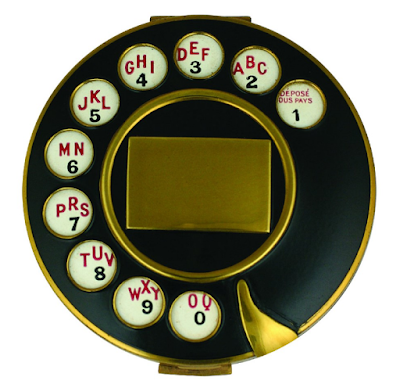 |
| Joyce & Frances' glamorous grannies, perhaps? |
Today, Dear Reader, I'm going to show off my Scottish, octogenarian girlfriends, Joyce & Frances - a couple of old girls who taught me everything I know about sewing machine anatomy & refurbishment and French polishing, to boot. Not to mention the boundless usefulness of Sewing Machine Oil and the value of Elbow Grease! (Nota bene: This is an image-heavy post and somewhat lacking in action, but Goats will be your reward if you make it to the end).
 |
| Do heed the straight talking advice of earlier eras That neglect to oil your machine will shorten its life & "cause you trouble and annoyance" |
I've been meaning to introduce you to this couple of friends in my little circle for ages, and after last week's post on the faithful and beloved Belgian RTT56 telephone, now seems as good time as any to meet some more olde worlde engineering which is to be found at home here.
 |
| Clydebank, the birthplace of Joyce & Frances |
As ever, things are done a little differently in the Pipistrello household, so when I was in the market for a new sewing machine last year, I decided to buy a solid workhorse from the past. My researching ultimately led to the Singer 99K, the first "portable" domestic sewing machine offered by them, designed for the Thrifty Housewife, and I found "Joyce" for $80 on Gumtree and brought her home.
 |
| Always a Major Investment, even by the late 50s The "Thrifty" Singer 99, at 53 Guineas, would cost Several thousand dollars today! |
She was already in good working order and had evidently been well regarded and serviced over the years, so it was not a hard task to spruce her up and after her electrical workings were checked by the brilliant, sewing machine mechanic I managed to find, she does run a straight-stitching dream.
 |
| Joyce seen recently sewing up some Masks for these Strange Times |
"Frances"* was found rather closer to home. In fact, she'd been living on the floor of a cupboard in our next-door neighbour's apartment for decades and was in rather a sorrier state when she was gifted to Your Correspondent and her resurrection became a bit of a Project, for which much trawling through the interwebs furnished me with more than enough DIY tips & tricks. Indeed, this path is very well-worn as millions of Singer sewing machines of all shapes and sizes were manufactured and similar eye-watering numbers are still happily sewing around the globe, many of which have been restored by hobbyists and sewers of all stripes**.
Shall we have a look at some before & after pics of Frances?
 |
| Mostly dust and rust, But some dodgy wiring to make me Hesitate taking her for a spin |
 |
| Not sewn a stitch in decades. What's underneath the throat plate? |
 |
| Phew! Just some dust bunnies |
 |
| The bobbin housing looks so much better! Metal polish is a faithful friend! |
 |
| Removing the face plate reveals Another section to tackle ... |
 |
| ... Ticked off the list! |
 |
| All the innards back in place & rather pretty now she's shiny |
Joyce & Frances are cousins***, as both are Singer 99K with the knee-lever motor and identical Filigree decorative touches. But what sane person needs twin machines? (obv. question), so I hummed and hawed about the fate of Frances. The wiring looked positively lethal, so I first anticipated converting her to a hand-crank, then when I took out and cleaned the knee-lever controller to polish the base, it looked so, well, safe! but I've since switched back to my original idea.
 |
| Oh, dear, Frances! |
 |
| Now looking as good as new, But the electrical bits will be coming out again To be replaced with a hand crank. |
So, while she works beautifully, she's still officially a work-in-progress until I buy the necessary bits to "downgrade" her to a manual machine. And I'm yet to finish restoring the plywood lid by filling the, ahem, hole and French polishing to match the base and I'm confident she'll be just dandy, and the perfect option in case the End-of-Days comes and the electricity is switched off forever!
 |
| A flesh wound to be getting on with ... |
* While owning two sewing machines may seem a little excessive for many reasons, not the least of which is I live in a 100 sqm apartment, I'm embarrassed to admit I do, in fact, own three machines. "Bernadette" is my rather flimsy and C21st offering, a cheap Bernette purchased nearly twenty years ago to sew some curtains, and did not get used for that purpose in the end, and when I finally pulled her out of her unopened box last year as I had a couple of projects in mind, she was a sorry disappointment once she got sewing, so she shan't get a photo to share with you. Plastic is consigned to a cupboard around these parts. Harsh but fair.
** And some ladies much more zealous than I who even pulled out cranks and driveshafts! But when your workshop is your tiny kitchen and your tools came from your bottom drawer and bathroom cabinet, neither of these girls were in a desperate enough state to warrant taking that more strenuous step.
*** Genealogical details are among the endless resources which can be investigated about the World of Singer Sewing Machines, and their serial numbers revealed 87-year old Joyce to be an Aquarius with 15,000 siblings and Frances a slightly younger Scorpio with 5,000 siblings.
 |
| Pulling out all stops for his Sales Pitch. A Singer promotion in 1910. Only in Queensland! |
Image credits: 1, 2: via Pinterest; 3: WorthPoint; 4: Trove; 5-14: Flying With Hands; 15: Wikimedia Commons


.jpg)


